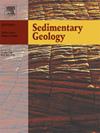Geochemical composition and grain size of surface sediments from reticulate dunes in the Tengger Desert, China
IF 2.9
2区 地球科学
Q1 GEOLOGY
引用次数: 0
Abstract
Reticulate dunes are the prevalent type of dunes found in deserts worldwide. However, compared to other dune types, systematic research on reticulate dunes remains limited, and aspects such as their formation mechanisms, grain size characteristics, and elemental composition characteristics remain inadequately understood. This study integrated regional wind regime data to analyse the grain size characteristics of reticulate dunes (specifically, the primary and secondary ridges) in the Tengger Desert, Considering both primary and sub-wind seasons. Additionally, we examined the elemental composition characteristics and degree of weathering of these dunes. The results indicate that the primary and secondary ridges of the reticulate dunes in the Tengger Desert are predominantly composed of fine sand and very fine sand with a mean grain size of 2.52Φ. Compared with other deserts in China and abroad, the sediments exhibit relatively finer grain sizes and better sorting. Furthermore, the grain size characteristics of surface sediments in the primary and secondary ridges exhibited two distinct distribution patterns during different wind seasons, indicating differences in the formation mechanisms of the primary and secondary ridges. The major elements in the surface sediments of the reticulate dunes in the Tengger Desert are SiO2 and Al2O3, while the predominant trace elements are primarily Ba, Sr, Zr, and Cr. This indicates that the geochemical composition of the sediments is influenced not only by the intrinsic characteristics of the elements but also by the regional climate and the supply of fresh materials, which are significant factors affecting their chemical behavior and content differences. The chemical weathering indices (CIA, residual coefficient, and ICV), along with the A-CN-K and A-CNK-FM triangular diagrams, suggest that the sedimentary environment of the reticulate dune sediments in the Tengger Desert is characterised by a cold, dry climate with a low degree of weathering. The weathering process occurs during the initial stages of plagioclase chemical weathering. These findings lay the foundation for further research on the formation mechanisms, evolutionary processes, and sedimentary environments of reticulate dunes, contributing to a deeper understanding of these complex geomorphological features.
腾格里沙漠网状沙丘表层沉积物的地球化学组成和粒度特征
网状沙丘是全球沙漠中最常见的沙丘类型。然而,与其他沙丘类型相比,对网状沙丘的系统研究还很有限,对网状沙丘的形成机制、粒度特征、元素组成特征等方面的认识还不够充分。本研究综合区域风况资料,分析了腾格里沙漠网状沙丘(主要是初级和次级山脊)的粒度特征,同时考虑了初级和次级风季。此外,我们还研究了这些沙丘的元素组成特征和风化程度。结果表明:腾格里沙漠网状沙丘的主垄和次垄以细沙和极细沙为主,平均粒径为2.52Φ;与国内外其他沙漠相比,沉积物粒度较细,分选效果较好。在不同风季,主次脊表层沉积物粒度特征呈现出两种截然不同的分布格局,说明主次脊形成机制存在差异。腾格里沙漠网状沙丘表层沉积物中元素含量以SiO2和Al2O3为主,微量元素以Ba、Sr、Zr和Cr为主,表明沉积物的地球化学组成不仅受元素本身特征的影响,还受区域气候和新鲜物质供应的影响,是影响其化学行为和含量差异的重要因素。化学风化指标(CIA、残余系数和ICV)及a - cn - k和a - cnk - fm三角图表明,腾格里沙漠网状沙丘沉积物的沉积环境为寒冷干燥、风化程度低的气候。风化过程发生在斜长石化学风化的初始阶段。这些发现为进一步研究网状沙丘的形成机制、演化过程和沉积环境奠定了基础,有助于对网状沙丘复杂的地貌特征有更深入的认识。
本文章由计算机程序翻译,如有差异,请以英文原文为准。
求助全文
约1分钟内获得全文
求助全文
来源期刊

Sedimentary Geology
地学-地质学
CiteScore
5.10
自引率
7.10%
发文量
133
审稿时长
32 days
期刊介绍:
Sedimentary Geology is a journal that rapidly publishes high quality, original research and review papers that cover all aspects of sediments and sedimentary rocks at all spatial and temporal scales. Submitted papers must make a significant contribution to the field of study and must place the research in a broad context, so that it is of interest to the diverse, international readership of the journal. Papers that are largely descriptive in nature, of limited scope or local geographical significance, or based on limited data will not be considered for publication.
 求助内容:
求助内容: 应助结果提醒方式:
应助结果提醒方式:


